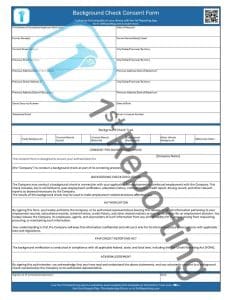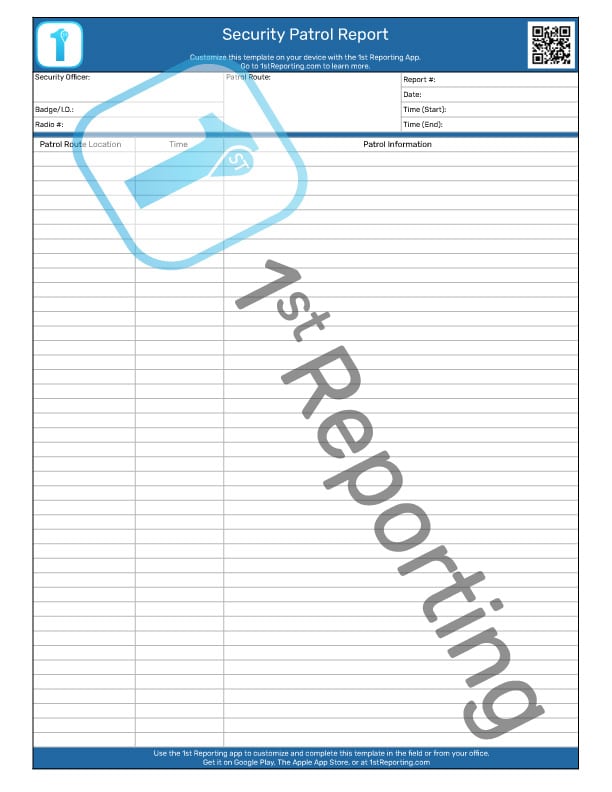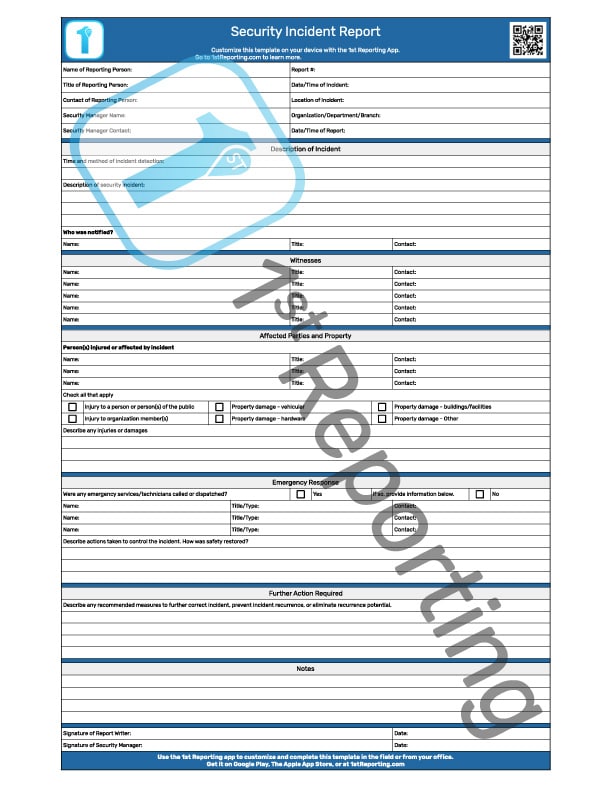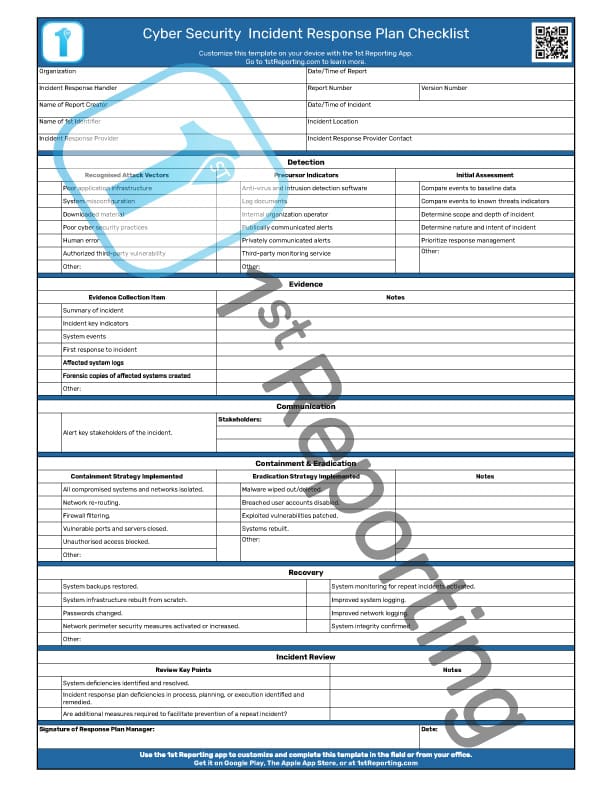The Background Check Consent Form is a vital tool for organizations in many sectors of today’s markets operating with strict hiring and vetting protocols. Using a written approval document assures organizations are following the appropriate protocol so they aren’t just onboarding individuals but trustworthy, proven individuals.
A background check consent form is a document that an interested party may use to acquire written permission to proceed with a background investigation of a person or business entity.
Given this form’s critical role, we must understand how to utilize it effectively. In this guide, I will take you through some basics of using the Background Check Consent Form. You can also download and print our pdf template right from this page. Or, if you’re ready to embrace the future, we’ve got you covered with a digital and customizable consent form inside our mobile app, 1st Reporting. Let’s get started.
Included in the Background Check Consent Form
The background check consent form has three primary components. The first section has fields for the applicant/candidate to include their personal information. The document’s second section consists of a selection row of different types of background checks. This section provides the standardization to allow firms to use this form for multiple background check types.
The second half of the document is the verbiage that builds the basis of the consent request and approval process. Naturally, the last section of the document requires the signature and date of the person providing consent. When completed correctly, this document should provide an organization with enough information and permission to conduct a background check.
You may find that there are certain aspects of the document you might need to change depending on the legislation in your particular state, province, or territory. Always consult with your local authorities to ensure our particular pdf form is suitable for you. If it isn’t and you need to adjust or customize it, we recommend you try using the form in a digital app instead. With its customization features, you can build entire forms from scratch, use our standard forms the way they are, or customize any form to fit your needs.
How To Use The Background Check Consent Form
Using our Background Check Consent Form is easy; just download the pdf and print as many copies as needed. It’s that straightforward. However, modifying the form can be a bit more challenging and is a lot more complicated, so we hope you like the generic form we’ve got for you.
I mentioned how each region, state, province, or territory may have different background check consent process requirements. In another article, Managing Background Check Consent For Security Firms, I’ve gone to some lengths.
There are a few considerations regarding the form and background check process. Let’s review them.
- Learn local legislation – Each state, province, or territory might have different regulations, and although our form may align with federal mandates, it might not suit your exact location. Due to the discrepancy between some regions and others, the best thing to do is find out in your local jurisdiction and act accordingly.
- Secure personal information – In the digital age, information is the new currency. With that in mind, we need to consider that the background check consent form has personal information about the applicant and therefore needs appropriate discretion. I recommend keeping confidential information and files in a secure storage location with strict key control policies.
- Always observe consent – If someone is unwilling or uncomfortable with sharing their personal information, you must observe their request. Of course, this might throw a wrench into the gears of the best-laid plans, but at the very least, the situation calls for discretion and professionalism. Please read my article on managing the background check consent process here. The article is geared toward the security industry, but the process is still the same and relevant for all sectors.
- Always document and communicate – I’ll go into more depth about this in the next section, but the idea is straightforward. The purpose of the form is to acquire written consent. Therefore, the form’s primary essence is open communication and documentation. Once the consent form is completed, the communication and documentation don’t stop there. Let’s look at some best practices next to explain further.
Follow Background Check Procedures
Okay, so let’s look at a scenario involving a company that has ten applicants for a role working in a secure area. Out of the ten applicants, one background check returns with a less-than-desirable result. The organization has standards for its hiring process, and unfortunately, the position can only accept four applicants to fill open positions. The organization knows they will take a pass on the individual with a negative background check. What do they do?
- Obtain Consent – The first step in the background check process is completing the Background Check Consent Form.
- Provide a Disclosure Statement – Under the Fair Credit Reporting Act (FCRA), you must provide the employee with a clear, written disclosure that you will be obtaining a background check report about them. This disclosure must be in a standalone document that doesn’t include other information.
- Provide Background Check Information – Provide the applicant with a copy of the background check result.
- Provide Written Intent – If you intend to pass on an individual because of their background check results, you must provide in writing that you intend to do so and why. This stage allows an applicant to correct any errors that may have been presented on the background check that might be affecting the results. In other words, if applicable, you must allow an applicant to refute any negative information.
- Maintain Confidentiality – Regardless of the decision, it’s essential to maintain the confidentiality of the background check results. You should restrict access to this information to those directly involved in the hiring decision.
- Comply with Record Keeping and Destruction Requirements – Depending on your jurisdiction, there may be specific requirements for how long you need to keep background check reports and consent forms and rules about how to dispose of them when no longer needed properly.
Remember to check with your state, province, or territory local authorities to ensure you follow the correct procedures for local legislation requirements.
Transitioning To Digital Background Check Consent Form Use
I’ve mentioned once or twice how we provide an application called 1st Reporting that enables organizations to digitally take their forms and documents. Let’s see what all the fuss is about.
Remember, every new technology aims to make our lives more efficient, but sometimes, the transition can seem overwhelming. That’s why our 1st Reporting app not only provides an accessible platform for digital forms but also focuses on usability and convenience, ensuring you can smoothly transition from PDF to digital. With just a few taps on your smart device, you can complete and submit the necessary forms, making the process streamlined and environmentally friendly.
The automated notifications feature, besides its convenient GPS functionality, compatibility with Microsoft Teams®, or dynamic form linking to chain events, is what I like about the app. You can get a notification to a specific person when a team member completes a particular form. You don’t realize how good this instant communication is until you’ve got it running in the field, and suddenly you know where your teams are at before they can dial your number to tell you – it’s sped up communication and reaction time exponentially. Goodbye paper forms, hello faster, more efficient service.






